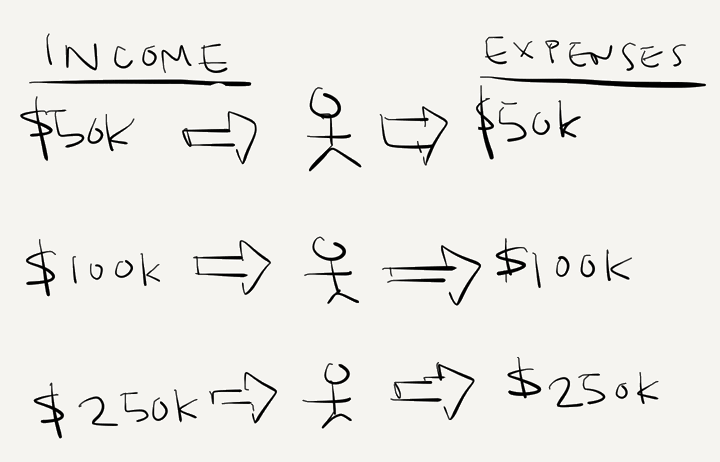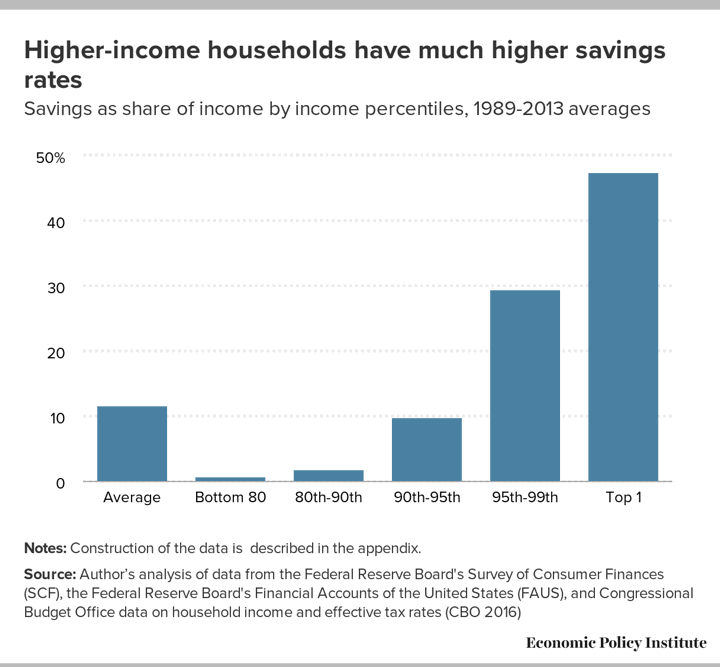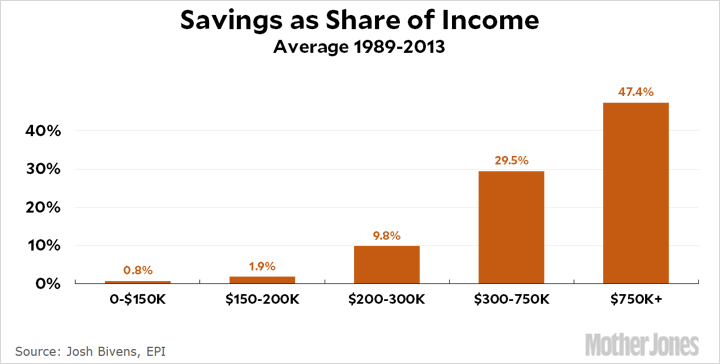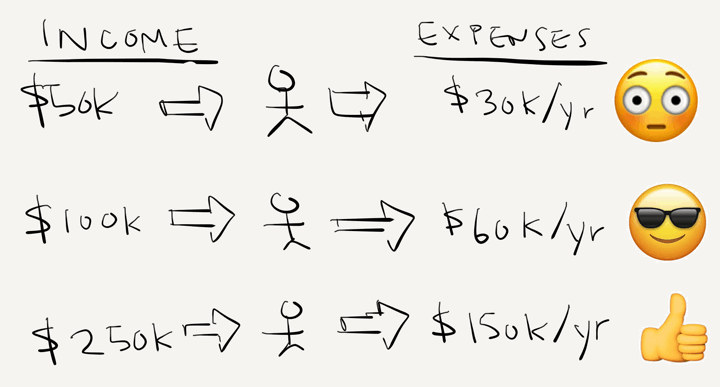One of the criticisms of the pursuit of financial independence is that it is “only for the rich”. Certainly, having a lot more money coming in every month should make it easier to set some of it aside. However, you might also observe that most people with higher incomes have higher expenses – bigger homes, faster cars, fashionable clothing, and so on. What if everyone is basically running on a hamster wheel, regardless of income?

In other words, a 0% savings rate:

Well, according to this Economic Policy Institute analysis based on the Federal Reserve Board’s Survey of Consumer Finances and other data from 1989-2013, this is not far from the truth for everyone up to the 90th percentile of households:

This Mother Jones chart converts the percentile numbers into annual household income:

This chart shows the problem with any statistics about “average savings rate across all households”. While the average savings rate might be 10%, it’s basically zero for 90% of households while over 50% for those making over $750,000 a year (some of whom are making far, far more than $750k a year).
If you are making over $200,000 a year, then you shouldn’t be too proud that you are maxing out your 401k at $19,500 a year in 2021. If that’s all you are saving, that’s less than a 10% savings rate and you are barely average. If you’re making over $300,000 a year and only maxing out your 401k and your IRA every year, then you’re saving much less than your income bracket peers.
However, the most intriguing discovery to me is that the savings rate for those making $150k to $200k annually is essentially the same (zero) as everyone making $40k, $75k, and $125k a year! Within that wide range from $0 to $200k a year, it turns out to be pretty close to a hamster wheel! If you have any sort of significant savings in this income bracket, you should feel a little better today. Why does every household earning up to $200,000 a year, feel a need to spend nearly all of it on average? Perhaps in this range, you still believe that you are receiving “value” for that additional spending in terms of comfort, security, convenience, and/or happiness. If you can afford it, you really want it.
Let’s roughly estimate an ongoing 40% savings rate of your annual income as being on pace for truly “early” financial independence. (This assumes relatively constant income, not a big windfall.) Someone making $100,000 would have to spend as if they made $60,000 a year. I don’t see why this is impossible, as someone making $60k also spends $60k.

If people spend what they earn, why can’t they just pretend they earn less? If only it were so easy. So many of our choices are rooted in deep psychological desires, a combination of evolution (nature) and our childhood experiences (nurture). We are social, comparative creatures and have so many cognitive biases they barely fit on a huge infographic with tiny font. As Morgan Housel explains in The Psychology of Money:
Doing well with money has a little to do with how smart you are and a lot to do with how you behave.
As the data shows, for 99% of the population, anyone saving 40% of their income is a rare bird. While it is a more impressive and rare feat to see someone making $50k and spending $30k while putting $20k a year into productive assets, than for someone making $250k and spending $150k, you don’t get extra points for difficulty level! You should still work on increasing that income.
Bottom line. The average household earning between $0 to $150,000 per year spends nearly every dollar they year, but so does the average household earning $150,000 to $200,000 a year. Why is this, and what can we learn from it?
[Hamster wheel image credit]
 The Best Credit Card Bonus Offers – October 2024
The Best Credit Card Bonus Offers – October 2024 Big List of Free Stocks from Brokerage Apps
Big List of Free Stocks from Brokerage Apps Best Interest Rates on Cash - October 2024
Best Interest Rates on Cash - October 2024 Free Credit Scores x 3 + Free Credit Monitoring
Free Credit Scores x 3 + Free Credit Monitoring Best No Fee 0% APR Balance Transfer Offers
Best No Fee 0% APR Balance Transfer Offers Little-Known Cellular Data Plans That Can Save Big Money
Little-Known Cellular Data Plans That Can Save Big Money How To Haggle Your Cable or Direct TV Bill
How To Haggle Your Cable or Direct TV Bill Big List of Free Consumer Data Reports (Credit, Rent, Work)
Big List of Free Consumer Data Reports (Credit, Rent, Work)
It is likely that a lot of those 150-200K households live in high-expense areas and are somewhat forced to spend most of their money. When you live in CA and did not buy your house a while ago, you have to spend $50K just on the house expenses, say another $35K on other basic expenses like food, gas, etc. Subtract income taxes, payroll taxes, health insurance and you’ll be pretty much left with nothing if you’re at around 150K. 200K is where it becomes more bearable for normal middle-class behavior.
Sure, but a decent chunk of those $150-$200k households have to be outside of HCOL areas, right? I would simply expect the difference overall to be greater than 1%.
I’m pretty sure that if those HCOL people would live in less high-expense area, they would also find a way to spend all that money, and they would use other excuses for it. Other way around, even if you live in an HCOL area there are countless ways to be smart with your money and keep a good portion of the 150k earnings. I just think it’s about lacking priorities (saving first), bad relationship with money or lack of proper knowledge about how to be smart with money.
What’s human NDA? A non-disclosure agreement for when you quit being a human?? hah…
😛 (made some edits and clarifications)
really enjoyed this thought provoking article. i save > 10% but should (and can) be saving more. guess i’ve been spoiled by market gains over the past decade doing most of the work. need to redouble my efforts
This is intriguing. And when you consider that these numbers go back to 1989 and factor in inflation, it becomes even more eye opening. $150k in 1989 would be about $330k today. And $200k would be about $440k. This is even more alarming. Obviously the equivalents from 2013 (when this study stopped) to today would be a little less alarming. But still something to consider as we try to compare this to today’s dollars.
The figures are adjusted for inflation. So when they say $150k from 1989 that is after increasing it to the equivalent amount of money today.
Here’s a question that always comes to mind for me, when calculating your saving rate is it the percentage from gross income or after taxes/take home, we save as much as we can probably about 100k yearly, between 2 401k, / Roth/ investment accts, on a gross income on a 250k combined salary, I always wonder which number pre or post tax they use for my own comparison, do they state in the article?
Does savings rate use the after tax income or pre tax income to calculate?
Its after tax.
Looking at the report from the EPI to see the source data. Looks like they figured the savings reates by calculating changes in net worth. And they calculated net worth for large chunks of the population by looking at how much entire sectors of financial assets go up or down for a period. So for example if Americans all bought $500 billion in stock in 2013 then thats an input and then they figure out how much stock increased and use that. And then if the top 1% of households held 50% of that stock their net worth was figured as going up $250B and if the bootom 80% ownly owned 1% then Same for other assets liek real estate.
So in short its complex caluclations to figure net worth changes for large %’s of the population.
This is very much not what I’d think of as ‘savings rate’. I think most of us think of ‘savings rate’ as income – expenses = savings. Thats not what they’re measuring though.
Thanks for your comment. The EPI savings rate does include things like capital gains, dividends, and business income as income. For the top 1%, this makes up roughly 90% of their income. But that makes sense to me… Jeff Bezos and Warren Buffett aren’t making their money from a salary or bi-weekly paycheck. Their true income is from owning part of a successful business, as with many 1%-ers I would guess.
For the paycheck earners, we have to slowly convert paycheck income into business ownership via stock purchases. The asset owners are getting richer faster than the worker salaries. I don’t know how to solve that gap, other than to keep trying to own more assets. Unfortunately, only 55% of Americans own any stock at all, per Gallup poll.
EPI also in the paper added in “government transfers” as part of income, which is not included by some other past measures. Not really sure exactly what this includes.
So is the calculation more of an annual increase in net worth as opposed to actual savings rate
I’d say that they adjust income for capital gains and interest for everyone. The IRS certainly taxes those things as income.
The paper says in its appendix : “The measure of saving used by Maki and Palumbo (2001) and this paper is the net acquisition of assets. ”
“net acquisition of assets” means that its looking at net worth changes.
It makes sense if you’re looking at the higher income folks since a billionaire doesn’t take his paycheck pay bills then put the remainder in savings. They have a pile of assets which increase in value.
The lower income earners save money from their paycheck and put it in the bank or pay down debt which has the net impact of changing their net worth.
So eitehr way looking at a change in net worth shows how much people are really gaining.
If we made more money, we’d probably spend it on private school for two children ($30k/y) and then on a house in a better neighborhood (expensive in California) before increasing our savings rate.
Staggering conclusions, hard to believe, but probably true.
I wonder how these numbers add up when comparing millennials with baby boomers. Hopefully it will show that millennials have a far better relationship with money, care more about their freedom compare to owning stuff that adds no value to their life, and thus safe more. And it might show that baby boomers still attach much value to owning nicer cars and nicer houses, and thus save less.
Human nature. The more they make, the more they will spend. Just like the government, they can charge the rich more taxes but they will also turn around and spend it all.
Of course, to be “different”, you have to spend a tier or two below what you actually make.
I note this does leave out the ‘forced savings’ due to social security withholding on the first $130k or so. Not that this should make us feel any better.